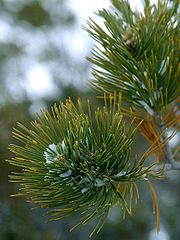|
Many plants have flowers that help them to make seeds in order to reproduce. You can learn about these plants on our flowering plants page. However, some plants do not use flowers to reproduce. These plants are called non-flowering plants.
There are two main groups of non-flowering plants. Plants that use spores to reproduce and plants that use seeds to reproduce. The non-flowering plants that use seeds are called gymnosperms. |
 The leaves (needles) of a non-flowering spruce tree |